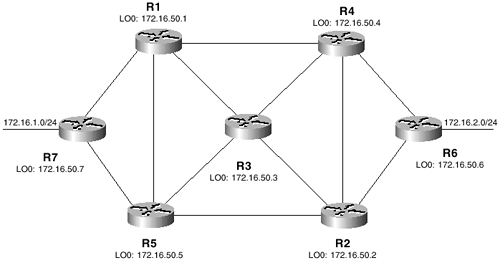| 1: | What global Cisco IOS Software command is required to enable IP multicast routing? |
| A: | ip multicast-routing |
| 2: | Show the commands that enable PIM on an interface in dense mode, sparse mode, and sparse-dense mode. |
| A: | [click here] ip pim dense-mode ip pim sparse-mode ip pim sparse-dense mode |
| 3: | Show the command to statically specify an RP with an address of 172.18.20.4. |
| A: | ip pim rp-address 172.18.20.4 |
| 4: | Write the configuration statements necessary to statically map groups 239.1.2.3 and 228.1.8.0 through 228.1.8.255 to RP 192.168.15.5, and group 239.6.7.8 to RP 192.168.20.10. Map all other groups to RP 192.168.25.1. |
| A: | [click here] ip pim rp-address 192.168.15.5 1 ip pim rp-address 192.168.20.10 2 ip pim rp-address 192.168.25.1 ! access-list 1 permit 239.1.2.3 0.0.0.0 access-list 1 permit 228.1.8.0 0.0.0.255 access-list 2 permit 239.6.7.8 0.0.0.0 |
| 5: | All router interfaces shown in Figure 6-11 are running in sparse-dense mode. Show the relevant configurations in order for R1 to be the RP for only groups whose addresses begin with 226.13.0.0/24. R2 should only be the RP for groups whose addresses begin with 239.0.0.0/8. R3 is the mapping agent; ensure that the mapping agent will recognize only R1 and R2 as RPs, and only for the specified groups. All Auto-RP messages should have a TTL of 20. Figure 6-11. The Topology for Configuration Exercises 5 “8  |
| A: | [click here] R1 ip pim send-rp-announce Loopback0 scope 20 group-list 1 ! access-list 1 permit 226.13.0.0 0.0.0.255 __________________________________________________________________ R2 ip pim send-rp-announce Loopback0 scope 20 group-list 1 ! access-list 1 permit 239.0.0.0 0.255.255.255 __________________________________________________________________ R3 ip pim rp-announce-filter rp-list 10 group-list 11 ip pim rp-announce-filter rp-list 20 group-list 21 ip pim send-rp-discovery Loopback0 scope 20 ! access-list 10 permit 172.16.50.1 access-list 11 permit 226.13.0.0 0.0.0.255 access-list 20 permit 172.16.50.2 access-list 21 permit 239.0.0.0 0.255.255.255 |
| 6: | Given the configurations of Configuration Exercise 5, suppose a source originates traffic for group 228.23.14.135, and a member requests a join to that group. What will happen? |
| A: | Neither R1 nor R2 is configured to become the RP for that group. Because all interfaces are running in sparse-dense mode, however, dense mode is invoked for the group, and an SPT is built between the source and member. |
| 7: | Again referring to Figure 6-11, write the necessary configurations to enable the bootstrap protocol, making R1 and R2 C-RPs for the same group addresses described in Configuration Exercise 5. Make R3 the BSR, and make R4 a backup BSR. |
| A: | [click here] R1 ip pim rp-candidate Loopback0 group-list 1 ! access-list 1 permit 226.13.0.0 0.0.0.255 __________________________________________________________________ R2 ip pim rp-candidate Loopback0 group-list 1 ! access-list 1 permit 239.0.0.0 0.255.255.255 __________________________________________________________________ R3 ip pim bsr-candidate Loopback0 50 _________________________________________________________________ R4 ip pim bsr-candidate Loopback0 0 |
| 8: | Write configurations for the topology in Figure 6-11 that allow multicast load balancing between source 172.16.1.75 and group member 172.16.2.100. Use unnumbered addressing on the tunnel interfaces, referencing E0, and assume the IGP is advertising those addresses. |
| A: | [click here] R6 interface Tunnel0 ip unnumbered Ethernet0 ip pim sparse-dense mode tunnel source Loopback0 tunnel destination 172.16.50.7 ! ip mroute 172.16.1.75 255.255.255.255 Tunnel0 __________________________________________________________________ R7 interface Tunnel0 ip unnumbered Ethernet0 ip pim sparse-dense mode tunnel source Loopback0 tunnel destination 172.16.50.6 |
| 9: | Examine the configurations of Homburg and Porkpie shown in the case study "Multicast Load Sharing." Each router is running OSPF in passive mode on the tunnel interfaces. Why? |
| A: | By putting the unicast protocol (in this case, OSPF) into passive mode, the protocol is aware of the interface addresses, necessary for the multicast RPF function, while at the same time preventing unicast traffic from using the tunnel. |
| 10: | What is the purpose of the command ip pim spt-threshold 100 group-list 25? |
| A: | When the arrival rate of packets for the group address or addresses specified in access list 25 exceeds 100 Kbps, the PIM-SM router switches from the shared tree to the shortest path tree. |